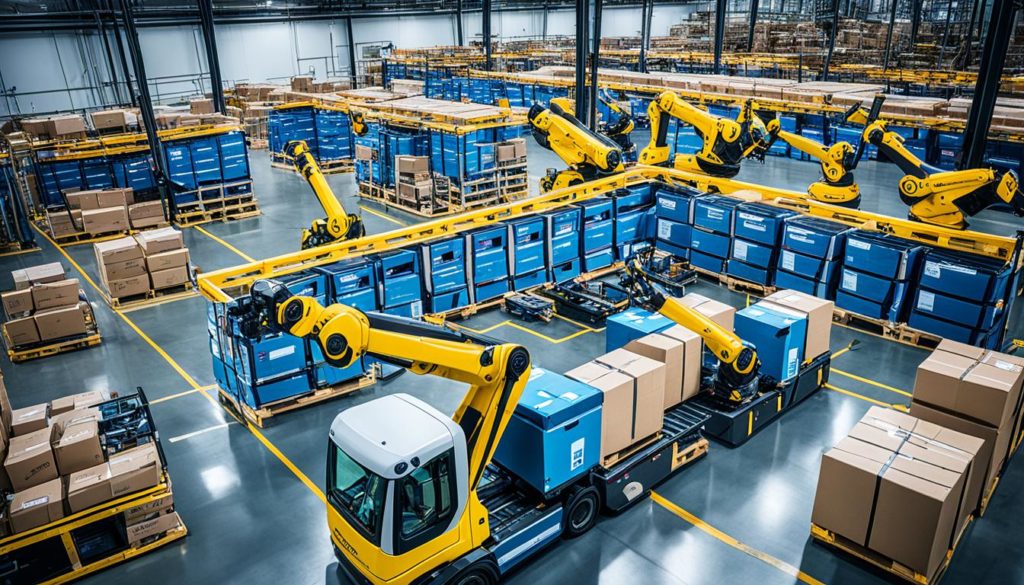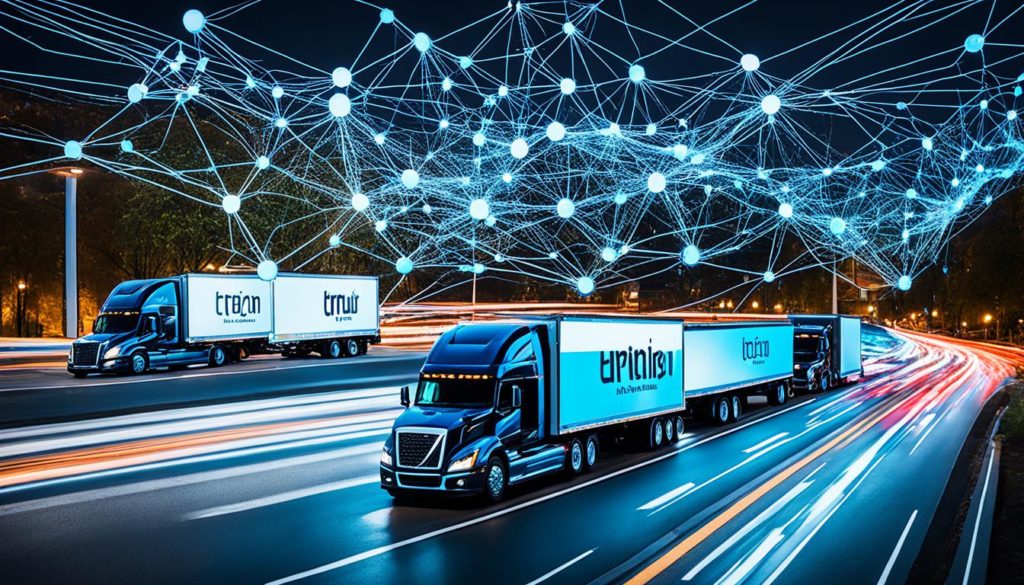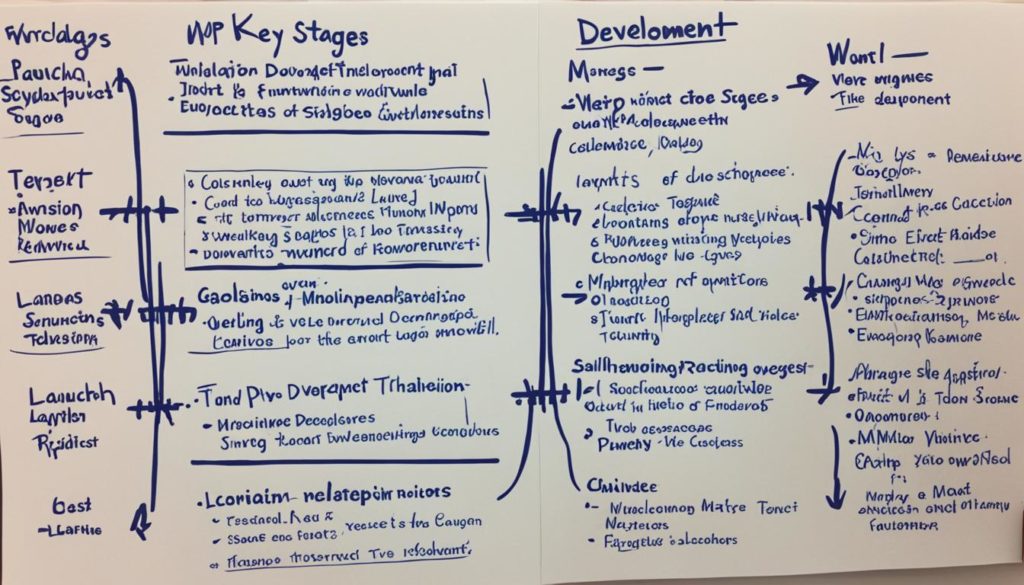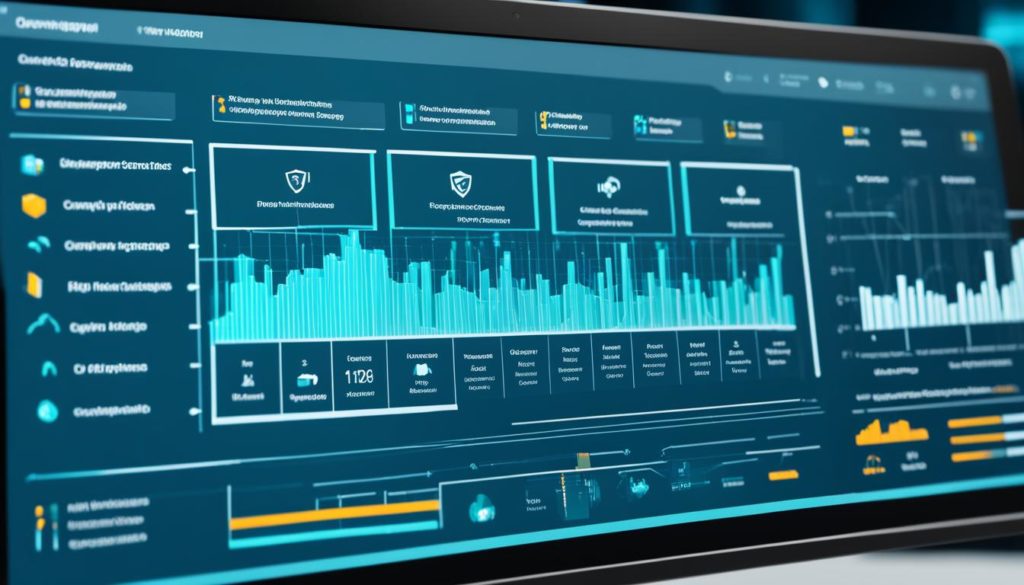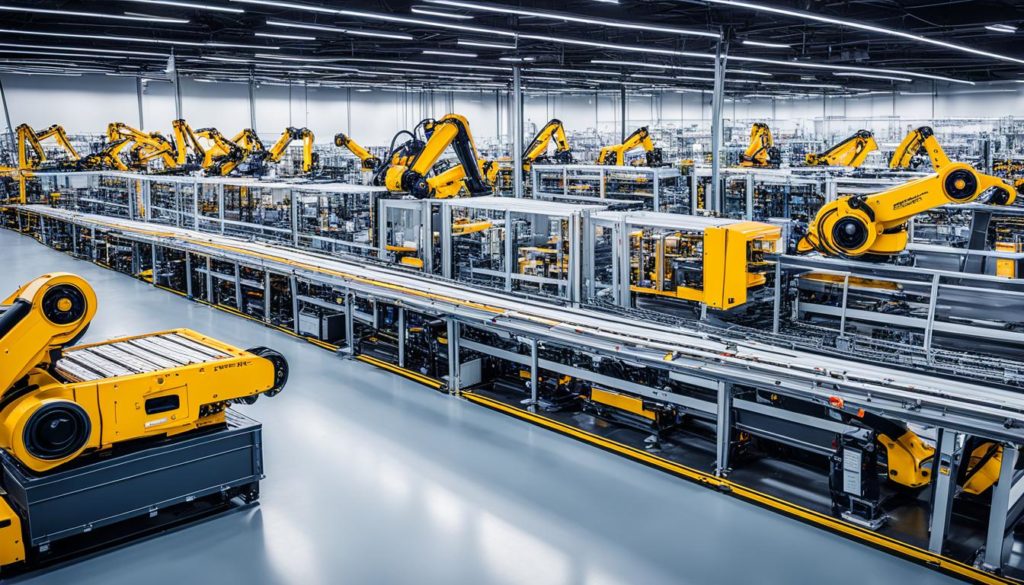
Do you know that AI in supply chain management could add $15.7 trillion to the world’s economy by 2030? This amazing figure shows how artificial intelligence can change logistics. It explains why businesses are quickly using these advanced technologies. Coca Cola’s demand forecasting and DHL’s route optimization show how AI is making logistics smarter and more precise.
The big change is moving from static to predictive logistics. Amazon and Walmart are leading this shift. Amazon uses AI in warehouses to keep the right amount of stock. This makes shopping easier for customers and reduces storage costs. Walmart uses Blockchain and AI for tracking food, making their supply chain more transparent and efficient.
Also, automated warehouse management with AI drones and robots is making processes faster and reducing mistakes. Predictive analytics from AI are changing how businesses forecast demand. This helps them keep the right amount of stock to maximize profits.
Moreover, AI algorithms improve transportation, cutting down on fuel use and making deliveries faster. This approach is speeding up transportation and making it greener. AI systems give us real-time tracking for supply chains. This lets us follow products from when they’re made to when they’re delivered, without missing a step.
Key Takeaways
- Significant Economic Impact: AI could bring $15.7 trillion to the global economy by 2030.
- Predictive Capabilities: AI helps forecast demand, optimizing stock levels for bigger profits.
- Efficiency and Sustainability: AI makes route planning better, reducing fuel and delivery times.
- Enhanced Transparency: Walmart’s use of Blockchain and AI improves how we track food, making things clearer.
- Operational Optimization: AI in warehouses with drones decreases errors and speeds up processes.
- Innovative Solutions: Companies like Amazon and Walmart use to change supply chain management.
Introduction to AI in the Supply Chain
Using AI in the supply chain is a huge step forward. Early days had manual work and data not connected. Now, AI changes all that by studying large amounts of data. This data includes market trends, what people like, and financial signs. Thus, AI brings new levels of predictability and efficiency to supply chains.
According to Gartner, use of machines in supply chains will grow a lot in five years. AI technologies improve how operations work. AI helps in predicting supply and demand. This makes managing inventory easier.
Global spending on IIoT Platforms is set to skyrocket by 2024. This shows many are moving towards AI to make supply chain operations better. AI tools help in managing warehouses better. They also make workplaces safer by cutting down mistakes.
Warehouse robots, for example, make operations cheaper and more precise. AI-driven inventory systems solve issues with having too much or not enough stock. They use real-time tracking and analytics.
AI processes lots of data to find and solve slow-downs in automated supply chain processes. AI gives clear insights for making supply chains better.
AI helps in understanding market trends and what customers want. This means less waste and better inventory control in supply chain operations.
Below is a table showing how AI impacts supply chain management:
| Metric | Traditional Supply Chain | AI-Driven Supply Chain |
|---|---|---|
| Operational Responsiveness | Low | High |
| Human Errors | Frequent | Reduced |
| Inventory Management | Manual and Inaccurate | Automated and Accurate |
| Cost Efficiency | Moderate | Optimized |
| Decision Making | Reactive | Predictive |
In 2023, President Biden stressed the importance of AI in supply chains. The Biden administration also allocated $52.7 billion to improve supply chain strength through the CHIPS and Science Act. By adopting AI, supply chains will see major benefits. This includes better efficiency, accuracy, and proactive choices.
Transformative Impacts of AI-Driven Demand Forecasting
Traditional demand forecasting methods can’t keep up in today’s ever-changing market. AI-driven supply chain forecasting offers a dynamic and accurate alternative. This approach improves supply chain management in various industries, making systems more efficient and effective.
The Shift from Static to Predictive Logistics
Old static models of demand forecasting can’t match the pace of today’s market. Using machine learning demand forecasting, businesses gain more precise insights. Predictive analytics help predict future demand with great accuracy, thanks to historical data and complex algorithms.
Techniques like regression, RNN, and LSTM help analyze huge amounts of data to find patterns. This not only boosts accuracy but also helps manage inventory better. It reduces waste and increases profits in sectors like retail, life sciences/pharma, semiconductor, and fintech.
Case Studies of AI-Driven Forecasting
Companies like Coca-Cola use AI to better predict market needs. In retail, this means keeping the right amount of stock, saving on storage, and selling more. AI helps them plan better, cut down on waste, and increase sales.
In life sciences/pharma, AI forecasting leads to better planning and less waste. The semiconductor industry uses it to avoid running out of supplies. Fintech firms improve their services and attract more users, which boosts their profits.
The role of AI was critical during challenges like the COVID-19 pandemic. It helped businesses adjust quickly to new demands and disruptions. AI-driven supply chain forecasting proved essential for keeping up with changes.
Here’s a look at the benefits for industries using AI-driven demand forecasting:
| Industry | Benefits |
|---|---|
| Retail | Optimized inventory levels, reduced storage costs, increased sales |
| Life Sciences/Pharma | Enhanced production planning, reduced waste |
| Semiconductor | Optimized production schedules, reduced supply shortages |
| Fintech | Improved service offerings, increased profitability |
AI-driven supply chain forecasting is crucial for staying ahead in the current market. It turns supply chain operations into more resilient, efficient, and profitable systems. Adopting this technology is not an option but a necessity for growth.
Supply Chain Optimization with AI in Real-Time
AI is changing the game in real-time logistics. It’s making supply chain management better. Companies worldwide use AI to get ahead. AI-powered route planning and inventory management make operations smoother and more efficient.
AI-Powered Route Planning
AI helps find the best routes for deliveries. DHL uses AI to make its deliveries more efficient. It looks at traffic, weather, and delivery needs. This cuts fuel use and helps the planet.
Using AI, we’re improving logistics like never before.
Enhanced Inventory Management
AI is changing how we manage inventory. Take Amazon, for example. Its AI predicts orders for just-right stock levels. This lowers storage costs and speeds up order sending.
By combining AI with supply chain work, businesses keep inventory just right. They meet demand without having too much or too little.
AI in Supply Chain: Enhancing Transparency and Efficiency
In today’s world, efficiency and speed are key in logistics. There’s also a big need for trust and seeing things clearly in supply chains. The mix of AI and blockchain makes things safer and lets us see info in real-time. Blockchain’s distributed ledger system, with AI’s smart analysis, helps track goods more precisely. It spots problems and makes sure things get delivered on time.
Walmart’s use of Blockchain and AI is a great example of success. They track food products in their supply chain closely. This not only makes the supply chain more see-through but also smooths out moving goods. This blend improves tracking accuracy and streamlines the whole process.
Now, let’s see how these techs make the global supply chain more open and efficient:
- Real-time insights that show where goods are right away.
- Better trust because of blockchain’s unchangeable records.
- Less human mistakes and more accuracy in moving goods.
- Better forecasts and stopping problems before they happen.
Below is a table showing key changes after using AI and blockchain in supply chains:”
| Aspect | Traditional Supply Chain | AI and Blockchain-Enhanced Supply Chain |
|---|---|---|
| Tracking Accuracy | Moderate with potential for error | High with real-time updates |
| Data Security | Vulnerable to breaches | Boosted by blockchain’s secure ledger |
| Efficiency | Slow and reactive | Quick and proactive |
| Transparency | Limited visibility | Wide open and clear |
Using AI and blockchain in supply chains is changing the game. It’s fixing old problems with transparency and efficiency. As we keep using these new ideas, logistics will become more reliable and smooth.
Conclusion
The future of logistics is on the brink of great change, thanks to AI technology. These changes will make our supply chains work better and stronger. With AI, we can make warehouses smarter and more automated, speeding up our work.
AI will also make logistics more sustainable and open. We’ll use AI chatbots to talk to customers and predictive analytics to keep things running without faults. This means our operations will not only be smooth but also dependable.
Getting on board with AI in supply management is key for businesses looking to lead. By investing in AI now, companies can become faster, more accurate, and transparent. Let’s move together into this new era, where AI makes logistics better for everyone.
FAQ
How is AI transforming the supply chain industry?
AI is making big changes in the supply chain world. It turns old, separate systems into broad, smart networks. These networks run on data and smart algorithms, boosting efficiency and speed in getting goods where they need to go.
What are some successful applications of AI in supply chain forecasting?
Big companies, like Coca-Cola, use AI to better predict what customers will want. By analyzing lots of different data, AI makes it easier to keep just enough stock on hand. This means less waste and lower storage costs.
How does AI improve route planning in logistics?
AI helps find the best paths for delivering goods. It looks at lots of factors to make deliveries faster and greener. For example, DHL is using AI to make sending packages more efficient.
What role does AI play in inventory management?
AI helps businesses keep the perfect amount of products stocked. At places like Amazon, AI systems make sure they have what customers want without overstocking. This cuts down on costs for storing goods.
How does the combination of AI and blockchain enhance supply chain transparency?
By using AI and blockchain together, companies can track goods more securely and in real-time. Walmart, for instance, uses these techs to follow food products closely. This helps them identify problems faster and improve how goods are delivered.
What are the future trends of AI in the supply chain?
AI is heading towards more automation in warehouses and the use of robots. It also involves chatbots to help customers and predictive tools for spotting maintenance needs early. All these will make shipping faster, cheaper, and more reliable.
How does AI contribute to sustainable logistics?
AI is making shipping and storage greener by cutting down on waste and energy use. It helps plan better routes and manage stocks more efficiently. This makes the whole supply chain friendlier to the environment.
“`
Feel free to add this FAQ section to your article on AI in the supply chain.
Future App Studios is an award-winning software development & outsourcing company. Our team of experts is ready to craft the solution your company needs.


